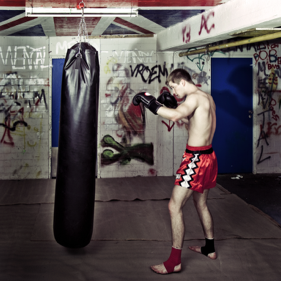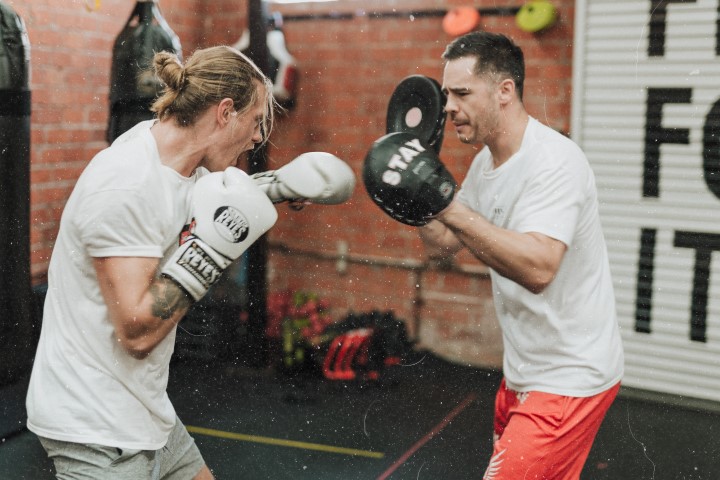The thing that you’ll find with the average fighter across the board is that they will more often than not have less-than-acceptable footwork. Although it is a large contributing factor and an extremely essential part of the boxing game, most fighters just want to punch and hit and work on blocking, and bypass working on their footwork.
Therefore, it’s important to set the record straight, especially if you are just starting out as a boxer: Footwork is extremely important. There are so many amateur-level competing boxers out there who have sub-par footwork and it shows. Oh, it shows.
If you think that it might be you and your boxing game is suffering from low-level footwork, then you’re probably right. Most boxers don’t reach up to their full potential simply because they are lacking in proper footwork training or don’t have the discipline to conquer footwork. It might also be because they completely bypass on the conceptual understanding of basic human anatomy —which is important for you to know if you really want to get the most out of your physical training and anatomy.
Instead of looking up boxing footwork pdf, boxing footwork drills youtube, and boxing footwork drills pdf, this guide has everything you need to know to be able to work on and possibly even master your footwork so that you can improve your boxing game and overall, become a better boxer.
I hope that this guide will help give you a few essential tips on boxing footwork basics on what to work on when focusing on your footwork in boxing which will ultimately raise your game. I’ll take you through some boxing footwork tips that can mean the difference between being mediocre and landing that knockout punch. Therefore, whether you’re looking for some boxing footwork drills for beginners or you are just in need of boxing footwork drills, period, I hope that this guide can be what you’re looking for.
1. Invest in Proper Boxing Shoes
Although you might just be getting started, investing in proper boxing shoes can give you the essential boost you need to start off on literally the right foot. If you are coming into training with just tennis shoes, then you’re already putting yourself at a disadvantage.
Boxing Shoes
These shoes will make your footwork and boxing instantly better and have an almost immediate effect on your game. Not only do they allow pivoting without sliding, they also will make you have a better grasp on things, feeling more agile and getting to the level of higher performance. If you invest in quality, you might be able to get your best boxing footwork possible.
For any boxing footwork drills solo training, you’ll need a good pair of shoes. Although you can add in extra features, like boxing footwork bands, which make footwork training more difficult, simply having quality boxing shoes can be an advantage in itself. Making this simple purchase, investment, and change can work wonders for your boxing game.
However, boxing shoes come with their own advantages and disadvantages, just like anything else. After I help explain what each of them is and how they can affect your boxing game, you can go on to read the chart I’ve added here that will help lay out the facts.
Non-Boxing Shoes

On the other hand, if you don’t want to invest and are walking in there with non-boxing shoes,you might instantly notice the difference, whether you are comparing yourself with other beginning students or if you run a little experiment of it on your own.
The first thing you’ll notice with non-boxing shoes is that the sole on the shoe is too thick for boxing footwork angles. Since they are originally created for shock absorption, they actually will eliminate a lot of the power that you need to be harnessed to transfer it to from ground into your punch. You also might realize that the whole sole of your foot won’t reach the ground, and when you’re doing boxing footwork patterns this might be a problem.
|
Boxing Shoes |
Non-Boxing Shoes |
|
An advantage of boxing shoes is that they can take that force from the ground and transfer it to your punches. They can do this without slipping, which means better balance, footwork, and punching power. |
When you’re working with sneakers or non-boxing shoes, you’ll have too much grip or too little grip, which is, of course, ineffective. |
|
Boxing shoes also lets your feet pivot as easily and smoothly as possible. They come with a non-sliding feature so you will feel as stable as possible, anchored to the ground and be able to deliver a full-powered punch with your whole body. |
Sneakers or non-boxing shoes may have too little grip, which will send you sliding all over the place. This is extremely ineffective in boxing. |
|
Since boxing shoes are much thinner than regular shoes or non-boxing shoes, they can get the full power from the ground and transition it much easier and smoother into the punch. The closer your feet feel to the ground, the better, so you can easily punch, pull, and push. |
Sneakers or non-boxing shoes may also have too much grip, which means that, although you won’t be sliding all over the place, you won’t be able to pivot properly, which will have an immediate and impacting affect on your punching power and angle. |
2. Focus on Jumping Rope
You might have already seen a lot of boxers jumping rope and know that it is a very important aspect of your boxing game. If you aren’t already jumping rope, you should start soon. It is a very beneficial exercise that works on your balance and power, among many other aspects of your game that you can work on simultaneously.
|
It Improves Your Conditioning |
Let’s face it. You can do all the running, swimming, and cycling that you want. But if you aren’t doing fitness and endurance tailored to boxing, it’ll be hard to efficiently use it when you’re in the ring. It is one of the only endurance exercises that mimic boxing |
|
Shows You How to Use Your Legs Efficiently |
Using your muscles efficiently is important to be efficient, overall, in the ring. This goes hand in hand with learning how to relax while you’re under pressure boxing. You’ll not only learn how to combine your technique and control your breathing while you’re jumping rope, you’ll also learn how to use those leg muscles efficiently. Other leg exercises won’t have this same effect. |
|
Improves Your Overall Foot Coordination |
Just like when you’re doing boxing footwork drills with ladder, jumping rope improves your foot coordination. There are so many different agility jumping workouts that can improve your coordination while you’re jumping rope. It’ll be difficult for you to be bored with it since there are so many resources to tap into. It works on your coordination because you have to concentrate not only on the rope but also on the movement of your feet, timing it perfectly while |
3. Keep Your Upper Body Relaxed
Whether you’re working on boxing footwork for beginners or are simply learning how to properly execute functional footwork, your upper body and lower body should be connected. A general rule to keep here is: movement first, position second.
Although you can work on both individually, you should always keep them connected. Your whole body should be with one another, which means that you should be understanding of how your body and movement work. Keeping your upper body relaxed is very important, as well.
All this movement can be connected back to your core, where it’s generated. Therefore engaging your core, no matter what you’re doing, and yet keeping your upper body relaxed is an important balance to conquer.
All sorts of movements, especially those who are most powerful, can be traced back to the core.Whether you’re pushing, pulling, or simply punching, all of these forces are generated from the most central part of your body: the core. It will keep your grounded and be your foundation.
Why all the talk about the core? Well, it is a major part of your upper body. With this, you have to learn how to not only engage your core but also to keep the rest of your upper body relaxed and your core ready for movement and explosion.
Here are a few facts about keeping your upper body relaxed:
|
Your Body is One Machine |
And a well-oiled one, at that. Which means that everything works together and you cannot work on one thing without the other. You cannot powerfully and effectively move one part of your body without moving the rest. Therefore all of your extremities are therefore an extension of your core. |
|
Being Stiff Doesn’t Help |
Just as I mentioned before: stay relaxed and loose. If you are stiff, you’ll be restricting your upper body and therefore your lower body movement. |
|
Don’t Hold a Frame |
It’s simply not good for you. You should not be holding tension with one part and trying to move or relax another. Don’t try and be perfect when it comes to positioning, especially defensively. You are most effective when you’re moving well, not perfecting every inch or detail like a statue or work of art. Boxing is about acting and reacting, so make it about movement rather than placement. |
4. Keep Concentration on the Balls of Your Feet

Whether you’re trying to or not, the balls of your feet are extremely important and should be the first things on and off the ground. With this tip, you’ll have to have a bit more knowledge of body anatomy. Here, you’ll be focusing on stepping with your metatarsals, which will ultimately benefit your overall control, increase your power, and hone in on agility.
This is important not only when boxing but also when shadowboxing or completing boxing drills for beginners. No matter what you’re doing, when you leave the ground, push off your weight, concentrating on the ball of your foot. When you are landing on the ground, you should be landing on the ball of your foot first before anything else—anatomically speaking.
However important they are, you shouldn’t be on the balls of your feet the whole time you’re
training or competing. Instead, simply focus on utilizing the ball of your feet as much as you can.If you can avoid it, stay away from using the heels because they have no muscles and will leave you out of control. On the contrary, the balls of your feel will overall give you more balance,power, and control.
|
“Do’s” |
“Don’ts” |
|
When you’re landing, try to push off directly from the balls of your feet. |
When you’re landing, don’t allow your weight to fall back on your heel. |
|
When you’re going forward, land on the ball of your foot first. |
When you’re stepping forward, do not do so with your heel. This is a slower movement because it is a 2-step process—moving from heel step to toe stop—whereas when you’re on the balls of your feet, it’s a 1-step process—just the ball first—toe step. |
|
When you’re concentrating on the balls of your feet, you’ll be granted two different |
|
6. Narrow Your Punching Accuracy and Stance

|
Wider |
Narrow |
|
If you are standing with a wider stance, you will be using much more energy than a |
If you have a more narrow stance, you’ll be able to pivot much easier than if your stance is wider. |
|
In general, a wider stance makes it harder for you to simply just stand. Since your legs |
When you’re going through boxing footwork,you should always try and keep a wider stance. |
|
If you are thinking that a wider stance will make you a more stable fighter—that doesn’t work. What a wider stance does in this situation is that it simply hides the fact that you have poor balance. A skilled fighter will then pick up on that and use it to his or her advantage. |
Not only is it more beneficial to have a narrow stance when you’re fighting, it also helps you develop better and forces you to become a better fighter. |
7. Take Shorter Steps

Nothing good will come from taking longer steps.
If you’re a beginner, you will feel tempted to take the longer steps to get as close as possible to your opponent. However, you’ll be doing more damage than good. It’s like a chain reaction, as you step far into your opponent’s range, they’ll either make a quick counter and you’ll be in trouble or they’ll step far away from you just to come back in harder and quicker than before.
Finding that sweet spot is important when you’re walking around the ring. Taking the smallest steps possible works best—not only because you’ll then be able to dish out a quick reaction, it’s also because you can be less predictable and easier to make your next move.
When you’re sparring or fighting someone else, you should try and stay within the edges of your range so that you always can go in and out. You will also be eliminating the necessity to spend any extra energy if you’re found outside that range. On that note, you should also take advantage of your entire reach, extending your arm as far as possible (without locking it). That extra inch or two makes a difference rather than having to move your entire body.
In general, making smaller steps saves you energy and also eliminates time that would be taken if you have to cover more space. Even if you are not as athletic as your opponent, you can still get to them quicker than they can get to you if you leave a close range between you two. Instead of working harder here, you can work smarter.
8. Learn to Walk

When you’re fighting, you should learn how to walk in between hits and combinations. Not only does this promote a break in the fight but it also keeps you moving. Since walking is how you move naturally and you don’t have to learn how to do it—although you should tweak your technique here and there to tailor it to the boxing ring—it is one of the easiest tips on this list.
By walking, you can use this movement to move around the ring. Simultaneously you can use this tip to be able to successfully stalk your opponent. You can also walk around the ring to evade them strategically instead of having to resort to bobbing, weaving, and quickly moving out of the way. One of the best things about walking is that it doesn’t take much energy to do. When you’re walking around the ring, focus on keeping your hips underneath you instead of resorting to jumping around, which takes much more energy. Keeping your hips square also allows you to move and twist much easier and quicker. Transitioning through your hips also require less energy instead of jumping around or frantically switching positions.
If you find yourself out of range, you can easily just walk around. That eliminates the necessity of jumping out of the way if your opponent decides to attack. Keeping yourself at a distance is a very important aspect in this area. Footwork plays a huge part of walking around the ring, which means that it’s important to work on.
9. Pivot Your Feet

There is a direct correlation between the direction of which your feet are pointing and which way
you should be going. Turning your feet to the direction where you want to go, it makes it much easier for you to move. When you’re moving forward, your feet are normally facing forward. They will make moving around and reacting in the ring much easier.
|
Moving backwards WITHOUT pivoting the feet. |
Moving backwards WHILE pivoting the feet. |
|
When you’re moving in a backward direction and taking a back step, this is one of the most simple ways to move. |
However, if you want speed, the back pivot will give yourself the extra edge you need that can save you in the long run. It is such a minor detail but instead of pushing yourself straight backwards and pivoting your feet first, you’re adding a small step but preparing your body beforehand to make the move. |
I hope that this guide of essential do’s, don’ts, and various Boxing Footwork Drills solo training has given you some direction when it comes to learning how to hone in and concentrate on your footwork. Whether you’re beginning to box for the first time or are just simply wanting to improve your footwork and are actually a more advanced boxer, I hope that these tips have touched on some points that you might not have already been aware of or you might need to be reminded of again.





